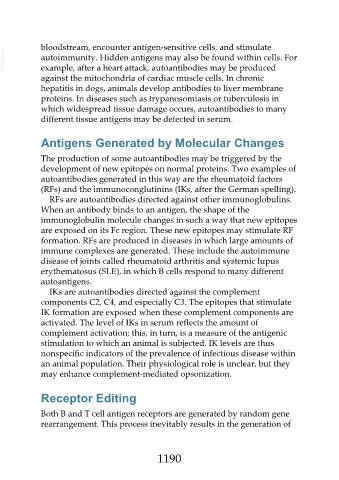Page 1190 - Veterinary Immunology, 10th Edition
P. 1190
bloodstream, encounter antigen-sensitive cells, and stimulate
VetBooks.ir autoimmunity. Hidden antigens may also be found within cells. For
example, after a heart attack, autoantibodies may be produced
against the mitochondria of cardiac muscle cells. In chronic
hepatitis in dogs, animals develop antibodies to liver membrane
proteins. In diseases such as trypanosomiasis or tuberculosis in
which widespread tissue damage occurs, autoantibodies to many
different tissue antigens may be detected in serum.
Antigens Generated by Molecular Changes
The production of some autoantibodies may be triggered by the
development of new epitopes on normal proteins. Two examples of
autoantibodies generated in this way are the rheumatoid factors
(RFs) and the immunoconglutinins (IKs, after the German spelling).
RFs are autoantibodies directed against other immunoglobulins.
When an antibody binds to an antigen, the shape of the
immunoglobulin molecule changes in such a way that new epitopes
are exposed on its Fc region. These new epitopes may stimulate RF
formation. RFs are produced in diseases in which large amounts of
immune complexes are generated. These include the autoimmune
disease of joints called rheumatoid arthritis and systemic lupus
erythematosus (SLE), in which B cells respond to many different
autoantigens.
IKs are autoantibodies directed against the complement
components C2, C4, and especially C3. The epitopes that stimulate
IK formation are exposed when these complement components are
activated. The level of IKs in serum reflects the amount of
complement activation; this, in turn, is a measure of the antigenic
stimulation to which an animal is subjected. IK levels are thus
nonspecific indicators of the prevalence of infectious disease within
an animal population. Their physiological role is unclear, but they
may enhance complement-mediated opsonization.
Receptor Editing
Both B and T cell antigen receptors are generated by random gene
rearrangement. This process inevitably results in the generation of
1190

